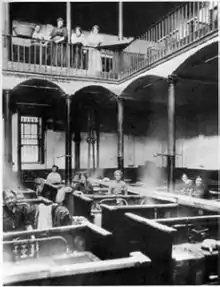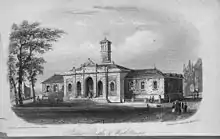
Baths and wash houses available for public use in Britain were first established in Liverpool. St. George's Pier Head salt-water baths were opened in 1828 by the Corporation of Liverpool, with the first known warm fresh-water public wash house being opened in May 1842[1] on Frederick Street.[2] Wash houses often combined aspects of public bathing and self-service laundry. The Romans, whom the Victorians often sought to emulate, had built many public baths (thermae) open to everyone, but these had long disappeared. For centuries Bath, Somerset, had retained its popularity as a health resort, while during the Georgian era and particularly after the development of the railway, entrepreneurs developed spa towns around the country, catering first to the aristocracy and then to the growing middle class. These commercial endeavours offered nothing for the working poor.
The popularity of wash-houses was spurred by the newspaper interest in Kitty Wilkinson, an Irish immigrant "wife of a labourer" who became known as the Saint of the Slums.[3] In 1832, during a cholera epidemic, Wilkinson took the initiative to offer the use of her house and yard to neighbours to wash their clothes, at a charge of a penny per week,[1] and showed them how to use a chloride of lime (bleach) to get them clean. She was supported by the District Provident Society and William Rathbone. In 1842 Wilkinson was appointed baths superintendent.[4][5]
Regulation
| Public Baths and Wash-houses Act 1846 | |
|---|---|
| Act of Parliament | |
.svg.png.webp) | |
| Long title | An Act to encourage the Establishment of public Baths and Wash-houses. |
| Citation | 9 & 10 Vict. c. 74 |
| Dates | |
| Royal assent | 26 August 1846 |
| Other legislation | |
| Repealed by | City of London (Various Powers) Act 1960 |
Status: Repealed | |
In 1844, the Committee for Promoting the Establishment of Baths and Wash-Houses for the Labouring Classes was formed with the Bishop of London as president.[8] The Bishop petitioned for a bill for the regulation of public baths and in 1846 Sir George Gray introduced the bill which became the Public Baths and Wash-houses Act 1846. This was the first legislation to empower British local authorities to fund the building of public baths and wash houses.[9]
The Act was intended to encourage cities to voluntarily build such facilities and was not mandatory.[10][11] Manchester, for example, did not adopt the Act until 1876; in the following year, it purchased two large, privately owned, facilities. By the late 19th century, the city had 30 bath houses.[12]
London baths
The first London public baths was opened at Goulston Square, Whitechapel, in 1847 with the Prince consort laying the foundation stone.[13][14] The building was demolished in 1989 and the site re-used to build the Women's Library in 2001, which incorporates a faux wash house frontage (Facadism).[15] A reasonably well-preserved bath house can be found in the Bathway Quarter in Woolwich, south east London.
Timelines
| Wash house | Opening date |
|---|---|
| Pier Head | 1828 |
| Frederick Street | 1842, rebuilt 1854 |
| Paul Street | November 1846 |
| Cornwallis Street | May 1851 |
| Margaret Street | 13 June 1863 with an extension in 1868 |
| Steble Street | April 1874 |
| Opening | Location | Original cost |
|---|---|---|
| 1849 | Marylebone | £23,671 |
| 1851 | St. Margaret and St. John, Westminster | £15,000 |
| 1852 | St. James', Westminster | £21,000 |
| 1852 | Poplar | £11,500 |
| 1854 | St. Giles and St. George, Bloomsbury | £20,857 |
| 1854 | Bermondsey | £16,500 |
| 1855 | St. George, Hanover Square | £33,861 |
| 1856 | St. Martin's in the Fields | £21,000 |
Other bath and wash houses: The Wells and Campden Baths and Wash Houses 1888–1978, Hampstead Heath.
See also
References
- 1 2 Ashpitel 1851, pp. 2–14
- ↑ Metcalfe 1877, p. 3
- ↑ "'Slum Saint' honoured with statue". BBC News. 4 February 2010.
- ↑ Wohl, Anthony S. (1984), Endangered lives: public health in Victorian Britain, Taylor & Francis, p. 73, ISBN 978-0-416-37950-1
- ↑ Rathbone, Herbert R. (1927), Memoir of Kitty Wilkinson of Liverpool, 1786–1860: with a short account of Thomas Wilkinson, her husband, H. Young & Sons
- ↑ Metcalfe 1877, p. 62
- ↑ Figure 1 from Ashpitel 1851
- ↑ Low 1850, p. 90
- ↑ "Baths and Wash-Houses". The Times. 22 July 1846. p. 6.
Yesterday the bill, as amended by the committee, for promoting the voluntary establishment in boroughs and parishes in England and Wales of public baths and wash-houses was printed.
- ↑ "Baths and Washhouses Act". UK Parliament. 29 April 2018. Retrieved 12 January 2021.
- ↑ "Timeline". Baths & Wash Houses Historical Archive. Retrieved 12 January 2021.
- ↑ "'Stunning' Victorian Bathhouse Unearthed Beneath Manchester Parking Lot". Smithsonian magazine. 11 January 2021. Retrieved 12 January 2021.
- ↑ "Classified Advertising". The Times. 26 July 1847. p. 1.
Model Public Baths, Goulston-square, Whitechapel. The BATHS for men and boys are now OPEN from 5 in the morning till 10 at night. Charges – first-class (two towels), cold bath 5d., warm bath 6d.; second-class (one towel), cold bath 1d, warm bath 2d. Every bath is in a private room.
- ↑ Metcalfe 1877, p. 7
- ↑ "The Women's Library". Londonmet.ac.uk. 26 March 2007. Archived from the original on 17 February 2011. Retrieved 10 January 2011.
- ↑ Metcalfe 1877, pp. 66–67
- ↑ Metcalfe 1877, p. 41
Bibliography
- Ashpitel, Arthur (1851), Observations on baths and wash-houses, pp. 2–14, JSTOR 60239734, OCLC 501833155
- Metcalfe, Richard (1877), Sanitas Sanitatum et Omnia Sanitas, vol. 1, Co-operative printing company
- Low, Sampson (1850), The charities of London, OCLC 5362638
